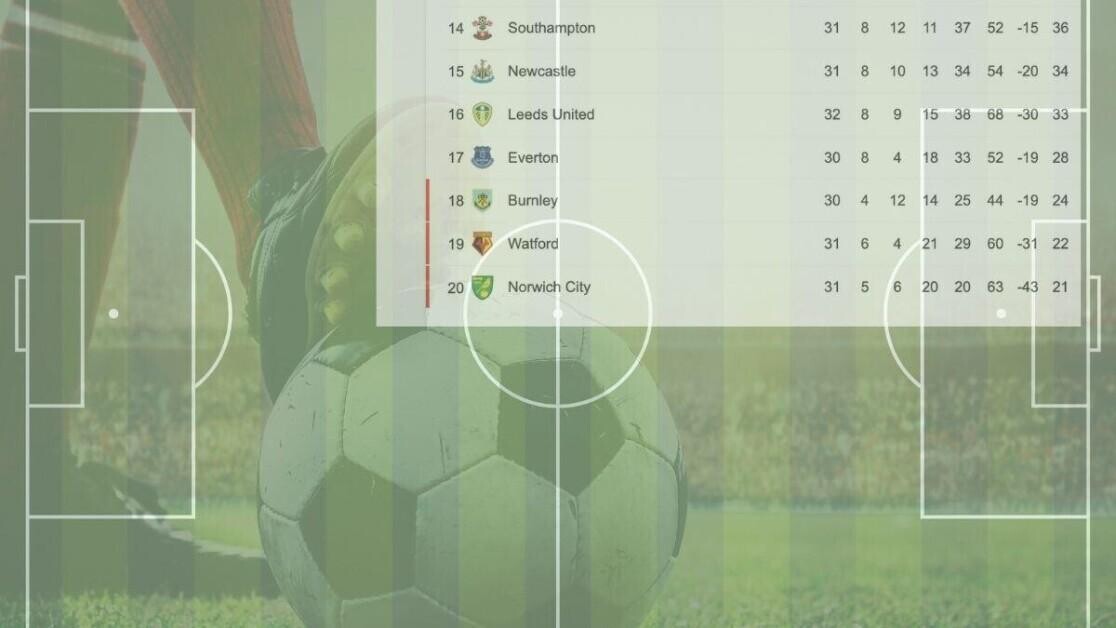
Your data guide to football betting, Dan Tracey shows you where the numbers point before the market catches up.
How Accurate is the 40 Points Marker?
When any football season reaches the month of April, the abacus starts to come out and for those teams languishing near the bottom of the Premier League, supporters will be working out just how many points are needed for survival.
While for those clubs who are attempting to earn another season in the top tier of English football, there is a hallowed marker that must be reached and with 40 being the magic number, that is the number of points required to stay up.
Or is it? Because after going some way to debunking the myth regarding Second Season Syndrome, we are now going to see if 40 points is essential in the Premier League and whether, these days, a lesser tally will be worth just as much.

Premier League - Second Season Syndrome
POINTS PER GAME
If 40 points earns you another stint in the promised land, we must first do the maths required to get there and with this equating to 1.05 points per Premier League game, 38 draws would not be enough for survival.
Not that any team would attempt to draw each and every game of the campaign, it is more to highlight the critical value of wins and when you consider that teams at the bottom lose more often, draws can also be worth their weight in gold.
At the end of the day, teams in peril will not be all that concerned as to how they earn the necessary number of points, just that they are collected in good time and now we are going to shine a light on those teams who have and have not needed 40 points in the past.
While to make this slightly simpler, we are going to overlook the first three seasons of the Premier League (1992/93 to 1994/95) and the reason for this, is that there were 22 teams in the competition.
This means with all things being equal from the 1995/96 season, we can now unveil the findings from our research.
| Pos | Team | Pts | Season | Season Rank | Status |
|---|---|---|---|---|---|
| 17 | Southampton | 38 | 1995/96 | 4 | Not Needed |
| 17 | Coventry | 41 | 1996/97 | 5 | Needed |
| 17 | Everton | 40 | 1997/98 | 6 | Needed |
| 17 | Southampton | 41 | 1998/99 | 7 | Needed |
| 17 | Bradford | 36 | 1999/00 | 8 | Not Needed |
| 17 | Derby | 42 | 2000/01 | 9 | Needed |
| 17 | Sunderland | 40 | 2001/02 | 10 | Needed |
| 17 | Bolton | 44 | 2002/03 | 11 | Needed |
| 17 | Everton | 39 | 2003/04 | 12 | Not Needed |
| 17 | West Brom | 34 | 2004/05 | 13 | Not Needed |
| 17 | Portsmouth | 38 | 2005/06 | 14 | Not Needed |
| 17 | Wigan | 38 | 2006/07 | 15 | Not Needed |
| 17 | Fulham | 36 | 2007/08 | 16 | Not Needed |
| 17 | Hull | 35 | 2008/09 | 17 | Not Needed |
| 17 | West Ham | 35 | 2009/10 | 18 | Not Needed |
| 17 | Wolves | 40 | 2010/11 | 19 | Needed |
| 17 | QPR | 37 | 2011/12 | 20 | Not Needed |
| 17 | Sunderland | 39 | 2012/13 | 21 | Not Needed |
| 17 | West Brom | 36 | 2013/14 | 22 | Not Needed |
| 17 | Aston Villa | 38 | 2014/15 | 23 | Not Needed |
| 17 | Sunderland | 39 | 2015/16 | 24 | Not Needed |
| 17 | Watford | 40 | 2016/17 | 25 | Needed |
| 17 | Southampton | 36 | 2017/18 | 26 | Not Needed |
| 17 | Brighton | 36 | 2018/19 | 27 | Not Needed |
| 17 | Aston Villa | 35 | 2019/20 | 28 | Not Needed |
| 17 | Burnley | 39 | 2020/21 | 29 | Not Needed |
| 17 | Leeds | 38 | 2021/22 | 30 | Not Needed |
| 17 | Everton | 36 | 2022/23 | 31 | Not Needed |
| 17 | Nottingham Forest | 32 | 2023/24 | 32 | Not Needed |
| 17 | Tottenham | 38 | 2024/25 | 33 | Not Needed |
First, we can have a look at each of the teams that finished 17th in the Premier League between the 1995/96 and 2024/25 seasons and of the 30 campaigns in our data table, only eight clubs recorded 40 or more points before staying up.
While we can highlight this better in the table below:
| Not Needed | 22 | 73.33% |
|---|---|---|
| Needed | 8 | 26.67% |
| Total | 30 |
This means of the 30 clubs that finished 17th in the Premier League between 1996 and 2025, only 26.67% required our magic marker for survival and therefore, 40 points are not quite as important as perhaps thought.
AN AVERAGE SCORE
While if we look at the same sample above and take the average points of each of these 30 clubs, 37.86 is the current midpoint for each outfit that has finished 17th in the Premier League – once again, going someway to debunking our latest football myth.
With that said, it is also clear to see a shift in what has been required over the years and between the 1995/96 to 2002/03 campaigns, six of the eight clubs that finished 17th recorded more than 40 points to keep them safe.
While the points threshold has changed significantly in the past decade and the last 10 seasons of the Premier League, only one team (Watford) needed 40 points to keep their heads above water.
While if we take the average points for 17th place finishes in the past decade, that figure equates to 36.9. Not only that, but we can see that the minimum value in this range was as low as just 32 points (Nottingham Forest 2023/24)
WHY SO SMALL
Now that we know less points are recorded by teams that finish 17th in the Premier League, we need to ask the question of why and to find the reason for this; we must start to look towards the very top of the table.
Because we are in an era of hyper-dominance in the Premier League and as the very best get even better, it means the likes of Manchester City and Liverpool are gobbling up more points than the champions before them.

The more points earned by the winners, the fewer points there are to go around at the bottom and with both Manchester City and Liverpool knocking very close to 100 points in recent years and in one case, Pep Guardiola’s men ended up as centurions, it means less is needed at the foot of the table.
That is not to say that it is easier to stay in the Premier League, if anything, it has become a lot harder in recent years and with everyone seemingly being pushed aside by both of Pep Guardiola and Jurgen Klopp’s men, it just means the target marker for survival now appears slightly closer.
Let’s take this sample of Premier League points from the winners and runners-up between 2018 and 2020:
| Pos | Team | Pts | Season |
|---|---|---|---|
| 1 | Manchester City | 100 | 2017/18 |
| 2 | Manchester United | 81 | 2017/18 |
| 1 | Manchester City | 98 | 2018/19 |
| 2 | Liverpool | 97 | 2018/19 |
| 1 | Liverpool | 99 | 2019/20 |
| 2 | Manchester City | 81 | 2019/20 |
Here you can see that of the six clubs that are in the sample, four of them have scored 97 points or above and when we compare it to the 17th place teams of the same season:
| PO | TEAM | PTS | SEASON | RANK |
|---|---|---|---|---|
| 17th | Southampton | 36 | 2017/18 | 26 |
| 17th | Brighton | 36 | 2018/19 | 27 |
| 17th | Aston Villa | 35 | 2019/20 | 28 |
You can see that neither of this trio needed nowhere near 40 points to stay up; in fact, they recorded three of four the smallest returns from the last decade and this reinforces the point of the more earned at the top, the less required nearer the bottom.
However, there is another way to look at this and that comes with the class of 2023/24's promoted teams from the Championship the season before. Because the trio of Luton, Burnley and Sheffield United scored such a low points tally, it was not just the champions Manchester City who were picking up an abundance of extra points, the spread of the points were far more top heavy than usual as the trio of clubs mentioned really toiled in the top tier.
A DIFFERENT ANGLE
Of course, we can look at this in a different direction and not by what the teams in 17th actually recorded but would they have actually needed. While the way to do this, is by looking at all the teams in 18th and what number of points they earned.
Here we can see the points of each of the clubs that were closest to safety but still ended up being relegated to the second tier and as you can see only three teams earned 40 points or more – West Ham’s 42 points is still a record number to be relegated in a 38 match Premier League season.
Now to get the better of a team in 18th, you must either record a higher number of points or at least better that team on goal difference and by using those metrics, we can see just how important 40 points really would have been.
First, we will look at this from a one point more point of view (17th place only needs a single point more than 18th to stay up)
| Pos | Team | Pts | Season | Plus 1 Point | Better Goal Diff |
|---|---|---|---|---|---|
| 18 | Manchester City | 38 | 1995/96 | 39 | 38 |
| 18 | Sunderland | 40 | 1996/97 | 41 | 40 |
| 18 | Bolton | 40 | 1997/98 | 41 | 40 |
| 18 | Charlton | 36 | 1998/99 | 37 | 36 |
| 18 | Wimbledon | 33 | 1999/00 | 34 | 33 |
| 18 | Manchester City | 34 | 2000/01 | 35 | 34 |
| 18 | Ipswich | 36 | 2001/02 | 37 | 36 |
| 18 | West Ham | 42 | 2002/03 | 43 | 42 |
| 18 | Leicester | 33 | 2003/04 | 34 | 33 |
| 18 | Crystal Palace | 33 | 2004/05 | 34 | 33 |
| 18 | Birmingham | 34 | 2005/06 | 35 | 34 |
| 18 | Sheffield United | 38 | 2006/07 | 39 | 38 |
| 18 | Reading | 36 | 2007/08 | 37 | 36 |
| 18 | Newcastle | 34 | 2008/09 | 35 | 34 |
| 18 | Burnley | 30 | 2009/10 | 31 | 30 |
| 18 | Birmingham | 39 | 2010/11 | 40 | 39 |
| 18 | Bolton | 36 | 2011/12 | 37 | 36 |
| 18 | Wigan | 36 | 2012/13 | 37 | 36 |
| 18 | Norwich | 33 | 2013/14 | 34 | 33 |
| 18 | Hull | 35 | 2014/15 | 36 | 35 |
| 18 | Newcastle | 37 | 2015/16 | 38 | 37 |
| 18 | Hull | 34 | 2016/17 | 35 | 34 |
| 18 | Swansea | 33 | 2017/18 | 34 | 33 |
| 18 | Cardiff | 34 | 2018/19 | 35 | 34 |
| 18 | Bournemouth | 34 | 2019/20 | 35 | 34 |
| 18 | Fulham | 28 | 2020/21 | 29 | 28 |
| 18 | Burnley | 35 | 2021/22 | 36 | 35 |
| 18 | Leicester | 34 | 2022/23 | 35 | 34 |
| 18 | Luton | 26 | 2023/24 | 27 | 26 |
| 18 | Leicester | 25 | 2024/25 | 26 | 25 |
Here are only four out of thirty 17th placed clubs that would have needed 40 points to stay up between 1996 and 2025. A figure that equates to just 13.3% of the sample above.
And if we look at this from a goal difference point of view (17th place only needs a better goal difference than that of 18th)
| Pos | Team | Pts | Season | Plus 1 Point | Better Goal Diff |
|---|---|---|---|---|---|
| 18 | Manchester City | 38 | 1995/96 | 39 | 38 |
| 18 | Sunderland | 40 | 1996/97 | 41 | 40 |
| 18 | Bolton | 40 | 1997/98 | 41 | 40 |
| 18 | Charlton | 36 | 1998/99 | 37 | 36 |
| 18 | Wimbledon | 33 | 1999/00 | 34 | 33 |
| 18 | Manchester City | 34 | 2000/01 | 35 | 34 |
| 18 | Ipswich | 36 | 2001/02 | 37 | 36 |
| 18 | West Ham | 42 | 2002/03 | 43 | 42 |
| 18 | Leicester | 33 | 2003/04 | 34 | 33 |
| 18 | Crystal Palace | 33 | 2004/05 | 34 | 33 |
| 18 | Birmingham | 34 | 2005/06 | 35 | 34 |
| 18 | Sheffield United | 38 | 2006/07 | 39 | 38 |
| 18 | Reading | 36 | 2007/08 | 37 | 36 |
| 18 | Newcastle | 34 | 2008/09 | 35 | 34 |
| 18 | Burnley | 30 | 2009/10 | 31 | 30 |
| 18 | Birmingham | 39 | 2010/11 | 40 | 39 |
| 18 | Bolton | 36 | 2011/12 | 37 | 36 |
| 18 | Wigan | 36 | 2012/13 | 37 | 36 |
| 18 | Norwich | 33 | 2013/14 | 34 | 33 |
| 18 | Hull | 35 | 2014/15 | 36 | 35 |
| 18 | Newcastle | 37 | 2015/16 | 38 | 37 |
| 18 | Hull | 34 | 2016/17 | 35 | 34 |
| 18 | Swansea | 33 | 2017/18 | 34 | 33 |
| 18 | Cardiff | 34 | 2018/19 | 35 | 34 |
| 18 | Bournemouth | 34 | 2019/20 | 35 | 34 |
| 18 | Fulham | 28 | 2020/21 | 29 | 28 |
| 18 | Burnley | 35 | 2021/22 | 36 | 35 |
| 18 | Leicester | 34 | 2022/23 | 35 | 34 |
| 18 | Luton | 26 | 2023/24 | 27 | 26 |
| 18 | Leicester | 25 | 2024/25 | 26 | 25 |
Only three teams would have needed 40 points (10%) and most importantly, not one team after West Ham’s haul would require that hallowed marker. This means no club from 2003/04 onwards has required 40 points to stay up.
On average since Leicester’s demotion in 2003, an average of 33.5 points has been required. This equates to two wins less than what may have been needed in the past and this once again, can be connected to big six dominance above.
Conclusion:
To wrap things up, it is fair to say that another myth has been busted and for those clubs that are looking to stay up this season, even as little as 33 points may be enough to beat the drop. So next time you hear the 40-point marker being spouted, just remember what you have read today.
Data from Premier League Wikipedia pages by each season – calculations by the author on 29th July 2025



